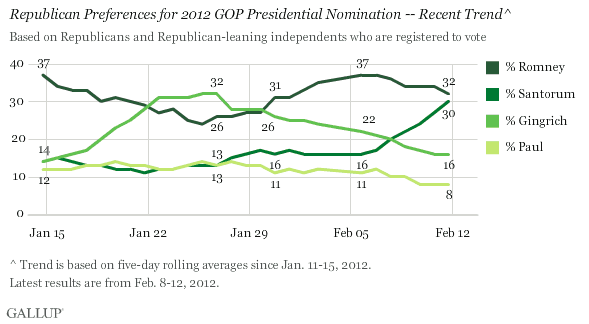PRINCETON, NJ -- Mitt Romney and Rick Santorum are now statistically tied for the lead in Republican registered voters' preferences for the 2012 GOP nomination -- 32% to 30%, respectively. Newt Gingrich, who led the field as recently as late January, is now third, favored by 16%, while Ron Paul's support has dwindled to 8%, the lowest level yet seen for him in 2012.

These results are based on Gallup Daily tracking from Feb. 8-12 -- the first Gallup tracking period conducted wholly after Santorum's sweep of the Feb. 7 state nominating contests.
Santorum's 14-point surge in support since just before Feb. 7, from 16% to 30%, appears to have come at the expense of all of his major opponents. Support for Romney and Gingrich has declined by five and six percentage points, respectively, over the same period, and support for Paul, by three points. The percentage unsure has increased slightly, from 11% to 13%.
Santorum's Wins Spur Robust Bounce
Santorum's surge coming off of his wins in Colorado, Missouri, and Minnesota is not unusual, given the volatility already seen in national Republican preferences. However, the magnitude of his 14-point gain over the five-day periods bracketing the Feb. 7 contests is the largest post-primary/caucus bounce Gallup has recorded since the primary season began.
By contrast, Romney's support grew by six points in the first five days after his apparent win in the Iowa caucuses -- with state election officials revising the results and declaring Santorum the winner a few weeks later. Santorum's support also swelled, by 12 points -- from 6% to 18% -- within the first week after he purportedly placed second in Iowa.
Romney then enjoyed a seven-point gain after winning the New Hampshire primary. Gingrich gained nine points after winning the South Carolina primary, building on a 10-point gain he made in the period between New Hampshire and South Carolina. Romney then recovered by 10 points after his decisive victory in Florida.
It is too soon to say whether Romney's slim victory in Saturday's Maine caucuses (or his important symbolic victory in the Conservative Political Action Conference (CPAC) straw poll the same day) will advance his support, thereby stalling or reversing some of Santorum's recent gains.

Bottom Line
Gallup Daily tracking conducted in the days after Santorum's sweep of three little-anticipated nominating contests last week shows national Republicans responding as they have each time there has been a big win or an upset in the caucuses and primaries thus far -- by jumping on the winner's bandwagon. Romney's win in Nevada on Feb. 4 represents the only exception to that, possibly because it was so closely followed by Santorum's victories on Feb. 7.
As a result, Santorum is now roughly tied with Romney for the lead, Gingrich has been relegated to third, and Paul is in a weakened fourth position. How long this scenario will last is anyone's guess, but will likely be dictated by the outcome of the next round of primaries at the end of February, in Arizona and Michigan.
Track every angle of the presidential race on Gallup.com's Election 2012 page.
Survey Methods
Results are based on telephone interviews conducted as part of Gallup Daily tracking Feb. 8-12, 2012, with a random sample of 1,162 Republicans and Republican-leaning independents who are registered to vote, aged 18 and older, living in all 50 U.S. states and the District of Columbia.
For results based on the total sample of registered Republicans and Republican leaners, one can say with 95% confidence that the maximum margin of sampling error is ±4 percentage points.
Interviews are conducted with respondents on landline telephones and cellular phones, with interviews conducted in Spanish for respondents who are primarily Spanish-speaking. Each sample includes a minimum quota of 400 cell phone respondents and 600 landline respondents per 1,000 national adults, with additional minimum quotas among landline respondents by region. Landline telephone numbers are chosen at random among listed telephone numbers. Cell phone numbers are selected using random-digit-dial methods. Landline respondents are chosen at random within each household on the basis of which member had the most recent birthday.
Samples are weighted by gender, age, race, Hispanic ethnicity, education, region, adults in the household, and phone status (cell phone only/landline only/both, cell phone mostly, and having an unlisted landline number). Demographic weighting targets are based on the March 2011 Current Population Survey figures for the aged 18 and older non-institutionalized population living in U.S. telephone households. All reported margins of sampling error include the computed design effects for weighting and sample design.
The questions reported here were asked of a random half-sample of respondents for five nights on the Gallup Daily tracking survey.
In addition to sampling error, question wording and practical difficulties in conducting surveys can introduce error or bias into the findings of public opinion polls.
For more details on Gallup's polling methodology, visit www.gallup.com.
